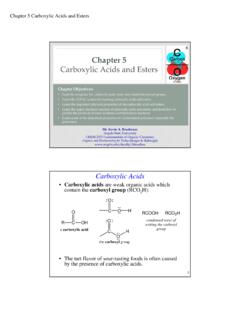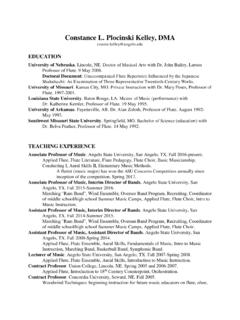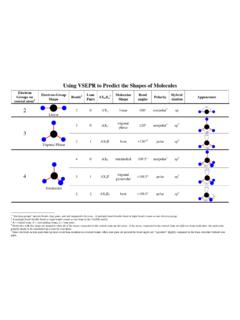Transcription of The Carbonyl Group - Angelo State University
1 chapter 4 Aldehydes and KetonesMr. Kevin A. BoudreauxAngelo State UniversityCHEM 2353 fundamentals of Organic ChemistryOrganic and Biochemistry for Today (Seager & Slabaugh) Objectives: Learn to recognize the aldehyde and ketone functional groups. Learn the IUPAC system for naming aldehydes and ketones. Learn the important physical properties of the aldehydes and ketones. Learn the major chemical reaction of aldehydes and ketones, and learn how to predict the products of hydrogenation, oxidation, and addition of alcohol reactions. Learn to recognize the acetal, hemiacetal, ketal, and hemiketal Group , and how these are related to aldehydes and 4 Aldehydes and KetonesThe Carbonyl Group2 The Carbonyl Group The Carbonyl Group (C=O) is found in aldehydes, ketones, and many other organic functional groups. The carbon and oxygen in the Carbonyl Group are sp2-hybridized, with bond angles of 120.
2 In ketones, two carbon groups are attached to the Carbonyl carbon, while in aldehydesat least one hydrogen is attached to the Carbonyl groupCRR'OCRHO ketonealdehyde3 Functional Groups Containing CarbonylsCRR'OCRHOCROOHCROOR'CROOCR'OCRN OHH ketonealdehydecarboxylic acidesteracid anhydrideamide4 Nomenclature of Aldehydes and Ketones5 Some Common Aldehydes and KetonesHCHOM ethanal(Formaldehyde)Gas at room temperature; 35-40% solution in water, called formalin, used to preserve biological specimens, sterilize instruments, and embalm cadavers; present in wood smoke,and helps to preserve smoked meats by killing (Acetone)1 billion pounds used annually in ; good solvent for most organic compounds, and is also soluble in water; solvent for coatings such as fingernail polish and enamel paints, (Acetaldehyde)Product of oxidation of ethanol in the liver; consuming large quantitiesof ethanol causes acetaldehyde to build up in bloodstream faster than it can be consumed in the liver to make other products, leading to nausea, sweating, reduced blood pressure, the odor of almonds and cherries, and is also foundin apricots and (Methyl ethyl ketone, MEK)Common industrial solvent6 chapter 4 Aldehydes and KetonesNomenclature of Aldehydes Select the longest carbon chain containing the Carbonyl carbon.
3 The -eending of the parent alkane name is replaced by the suffix -al. The Carbonyl carbon is always numbered 1. (It is not necessary to include the number in the name.) Name the substituents attached to the chain in the usual CH2CH3 CHO7 Nomenclature of Ketones Select the longest carbon chain containing the Carbonyl carbon. The -eending of the parent alkane name is replaced by the suffix -one. Number the chain starting with the end closest to the ketone Group (the Carbonyl carbon should have the lowest possible number). The location # for the ketone Group precedes the name for the longest chain. Name the substituents attached to the chain in the usual : Naming Aldehydes and Ketones Name the following compounds:CH3 CHCH2 CHOBrCH3 CHCHCH2 CCH3CH3 OHCH3CH CH CCH3CH3CH3 OCH3 CCHCH2CH3 OCH2CH39 Other Nomenclature Rules In cyclic ketones, the Carbonyl Group is always numbered 1 ; this does not need to be included in the name.
4 The numbering continues clockwise or counterclockwise to give the lowest number for the next substituent. Molecules with more than one ketone Group are named by preceding the suffix with a counting prefix (dione, trione, etc.); position numbers must be used for each ketone Group . Aromatic aldehydes (containing an aldehyde Group directly attached to a benzene ring) are named after the parent compound benzaldehyde. (The carbon to which the aldehyde Group is attached is carbon 1 ).10 Examples: Naming Aldehydes and Ketones Name the following compounds:OOCH3CH3 CCCH3 OOOCH3CH2 CCCH3 OOCH3 CHCH3CH2 CHCH311 Examples: Naming Aldehydes and Ketones Name the following compounds:CHOCH3CH3 CHOBrCHOCH2CH3CH312 chapter 4 Aldehydes and KetonesExamples: Naming Aldehydes and Ketones Draw structural formulas for the following molecules: 3-ethyl-2-pentanone 2,4,6-trimethylheptanal 3-ethylcyclopentanone13 Examples: Naming Aldehydes and Ketones Draw structural formulas for the following molecules: 4-chloro-2-phenylpentanal para-nitrobenzaldehyde 3-ethyl-2-butanone (what s wrong with this name?)
5 14 Physical Properties of Aldehydes and Ketones15 The Polarity of the Carbonyl Group Carbonyl compounds are polar, containing a dipole along the carbon-oxygen double bond. This creates weak attractive forces between Carbonyl compounds, but these attractions are not as strong as those that result from CO CO CO 16 The Boiling Points of Aldehydes and Ketones Since there is no hydrogen on the Carbonyl oxygen, aldehydes and ketones do not form hydrogen bonds with themselves. Aldehydes and ketones therefore have boiling points that are in between those of alcohols and hydrocarbons of the same molecular weight: Alcohols form hydrogen bonds, and have high boiling points. Hydrocarbons are nonpolar, and have low boiling points. Aldehydes and ketones are polar, so they have higher boiling points than hydrocarbons, but they are not as polar as molecules which can hydrogen Boiling Points of Aldehydes and Ketones18 chapter 4 Aldehydes and KetonesPhysical Properties of Aldehydes and Ketones Carbonyl compounds cannot hydrogen-bond to each other, but they can hydrogen-bond to water through the Carbonyl oxygen.
6 Low-molecular weight aldehydes and ketones are water-soluble; water solubility decreases as the size of the molecule 'OHOR'CROH 19 Physical Properties of Aldehydes and KetonesNameMolecular weightBoiling pointSolubility in waterbutane58 g/mol0 CInsolublepropanal58 g/mol49 CSolubleacetone58 g/mol56 CSoluble1-propanol 60 g/mol97 CSolubleBoiling Points:AlcoholsAldehydes/KetonesEthersAl kanesWater Solubility:AlcoholsAldehydes/KetonesEthe rsAlkanes20 Examples: Predicting Boiling Points Arrange the following compounds in order of increasing boiling point: 2-pentanone 2-methylpentane 2-pentanol2122 Some Important Aldehydes and Ketones23 Important Aldehydes and KetonesHCCOHG lucoseOne of the most important of the carbohydrates, which are polyhydroxyaldehydes and ketones; the metabolismof glucose is a major source of energy for living organismsCCCCH2 OHHHOOHHOHHHOCH2 OHCOCCCCH2 OHHHOOHHOHHF ructoseAnother important carbohydrate; a major component of corn syrup; foundin honey, syrups, and preserves; in combination with glucose it forms the disaccharide 4 Aldehydes and KetonesImportant Aldehydes and KetonesHOCH2 CCH2 OHDihydroxyacetoneActive ingredient in "bronzers" that provide fake suntan coloration; reacts with dead, outer skin cells to produce a darker color; fades as the dead skin cells slough in oil of clove; also present inthe odor of many fruits and dairy products, and is also responsible for the odor of blue in Vanilla beans(parent compound of the vanniloids)OZingerone (vanillyl acetone)The pungent, hot component of gingerCH3 OHOO25CH3 AcetophenoneUsed in perfurmery, and as an organicsolvent.
7 Also used in the synthesis of some pharmeceuticalsOCH3CH3CH3 OCamphorIsolated by steam distillation from the camphor tree of China and Japan. Camphor is a counter-irritant (produces a superficial inflammation to reduce deeper inflammation) and antipruritic (anti-itching) medication; it appears to selectively stimulate cold sensors. It also stimulates the respiratory systems and inspires deep breathing, but can cause convulsions and respiratory collapse in larger in hyacinthHOCitronellalFound in citronella oil; used as an insect repellantHOHOC innamaldehydeThe flavoring in oil of cinnamon; obtained by steam distillation from the bark of the cinnamon tree; has a carminative action (releases hydrogen sulfide, methane, and hydrogen from the intestine)2-MethylundecanalOne of the first of the synthetic perfumes, introduced by Coco Chanel in 1921 as Chanel No. 5CH3OH273-(para-Hydroxyphenyl)-2-butanon eResponsible for the odor of ripe 2-pyridyl ketoneFound in the odor of popcornNOVitamin K1A fat soluble vitamin btained from green leafy vegetables, cabbage, cauliflower, kale,spinach, pork liver; also made by intestinal bacteria.
8 Essential for blood from the breakdown of triglycerides in meat during cooking; theacrid smell of this compound is obvious during barbeques. It also contributes to the taste of caramel, where it is producedby decomposing sucroseHO28 HumuloneA component of hop resin, a viscous yellow material obtained from the blossoms of the female hop plant (Humulus lupulus); it adds to the bitter taste of some for the odor of freshly picked raspberries, violets (and the extract, oil of violets), and sun-dried volatile yellow liquid compound with the odor of cheese; gives butter its characteristic flavor. It also contributes to the odor of armpits and unwashed feet by the action of bacteriawhich ferment the compounds in Few SteroidsSteroid nucleusOHCH3CH3 OTestosteroneA male sex hormoneCCH3CH3 OCH3 OProgesteroneAfemale sex hormoneOHCH3 OCCHN orethynodrelActive ingredient in birth-control pills30 chapter 4 Aldehydes and KetonesReactions of Aldehydes and Ketones31 Oxidation of Alcohols to Produce Carbonyls Aldehydes, like primary alcohols, can be oxidized to produce carboxylic acids: Secondary alcohols can be oxidized to produce ketones, which are not further oxidized:RCHHOHCORHCOROH[O][O]aldehyde1 alcoholcarboxylic acidRCHR'OHCORR'[O]2 alcoholketone32 Examples: Oxidation Reactions Complete the following reactions:CHO[O]CH3 CCH3[O]OCCH3 CHCH2 OHCH3[O]33 Examples: Oxidation Reactions Complete the following reactions:OH[O]CHCH3 CHCH2 OHCH3CH3[O]34 Oxidation of Aldehydes.
9 The Tollens' Test Tollens reagentis a mild oxidizing agent composed of silver ions in an aqueous basic solution of ammonia. Aldehydes are oxidized to carboxylate salts (since the solution is basic), and the silver ions are reduced to solid silver, which coats the bottom of the test tube with a silver mirror. Ketones are not oxidized, so no silver mirror NH4+2 Ag(NH3)2(OH)2aldehydeTollen's reagentsilvera carboxylate salt++++3NH32 AgH2 ORCORNR2 Ag(NH3)2(OH)2ketoneTollen's reagent+35 Examples: The Tollens Test What observations would be made in the following reactions?CH3CH2 COHT ollen'sreagentCH3 COCH3 Tollen'sreagentTollen'sreagentCHOT ollen'sreagentUnknownsilver ppt36 chapter 4 Aldehydes and KetonesHydrogenation of Aldehydes and Ketones Hydrogenationof aldehydes and ketones with hydrogen gas and a platinum catalyst produces alcohols:RCHRCHHan aldehyde+ H2a primary alcoholPtOOHRCR'RCR'Ha ketone+ H2a secondary alcoholPtOOH37 Examples: Hydrogenation Reactions Complete the following reactions.
10 CH3CH2 CHH2+PtOCH3 CCH3H2+PtOH2+PtO38 Addition of Alcohols to Aldehydes Aldehydes react with alcohols first to form hemiacetals, which then react with excess alcohol to produce ' OHRCHOR'R'' OHRCHOR'hemiacetalacetalaldehydeH+H+OOHO R''CH3 CHCH3 OHCH3 CHOCH3CH3 CHOCH3CH3 OHH+H+OOHOCH339 Addition of Alcohols to Ketones Ketones react with alcohols first to form hemiketals, which then react with excess alcohol to produce 'R'' OHRCR'OR''R''' OHRCR'OR''hemiketalketalketoneH+H+OR'''O HOCH3 CCH3CH3 CCH3 OCH3CH3 CCH3 OCH3H+CH3 OHH+CH3 OHOOHOCH340 Hemiacetals, Acetals, Hemiketals, and Ketals(oh my)CH3 CHa hemiacetalhemiacetal carbonOHOCH3CH3 CHOCH3an acetalacetal carbonOCH3CH3 CCH3 OCH3a hemiketalhemiketal carbonOHCH3 CCH3 OCH3a ketalketal carbonOCH341 Examples: Identifying Acetals and Ketals Identify the following compounds as being acetals, ketals, hemiacetals, or 4 Aldehydes and KetonesExamples: Identifying Acetals and Ketals Identify the following compounds as being acetals, ketals, hemiacetals, or : Formation of Acetals and Ketals Complete the following reactions.









